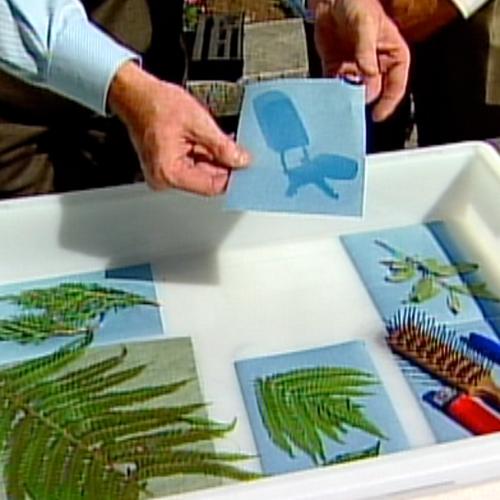Make amazing white on blue prints with your favorite objects! Just place leaves, flowers, shells, or whatever you choose on the photosensitive paper and place it in the sun. Remove the objects after a couple of minutes and rinse the paper to “fix” it.
Nature Sun Sensitive Paper
Make amazing white on blue prints with your favorite objects!

Here's What You'll Need
-
Sun Sensitive Paper
-
Water
-
Cardboard and push pins to keep your prints in place or a shallow tub where the paper will be protected from blowing away in the wind
-
Objects to take a "picture" of on the photosensitive paper
-
Split Demo Tank (optional)
Experiment
- Place your Sun Sensitive Paper, blue side up, in the shallow tub or pin the corners to a piece of cardboard for stability.
- Place the objects you wish to “print” on top of the paper. If your objects are particularly lightweight, you can hold them in place with a piece of clear plastic wrap.
- Expose the paper to the sun for 2-4 minutes, until the Sun Sensitive Paper turns very pale blue.
- Remove the paper from the tray or cardboard and soak it in water for about one minute. In the video, Steve uses the Split Demo Tank to better observe the change that occurs when the paper is placed in water.
- Remove the paper from the water and let it dry flat. The image will sharpen as it dries.
Now Try This!
Another interesting way to see the chemical reaction that occurs with Sun Sensitive Paper is to test the effect of different types of light sources on the paper. You can test different light sources and the effect that various exposure times play in the process.
Some light sources to try:
- 100, 60, 40, 25 and 15 watt light bulbs
- Green, red, blue, yellow and black light
- Fluorescent light
- Bug light
- Infrared heat lamp
Try exposing the paper to each light source for set intervals of time, with zero exposure being your control in the experiment. Record your data and compare results between the light sources and exposure times.
How Does It Work?
The Sun Sensitive Paper is coated with light-sensitive chemicals, which react to light waves and particles when exposed to light. When you place objects on the paper, they block the light and turn white while the paper around them remains blue. Water stops the process and fixes your images on the paper.
In the lab, photosensitive paper is made by coating a sheet of paper with a water-soluble, bluish-green compound called iron (III) hexacyanferrate (III), Fe[Fe(CN)6]. The common name for this chemical is Berlin Green, a well-known photosensitive chemical. When exposed to ultraviolet light (UV), a chemical reaction takes place where the water-soluble Berlin Green changes into a water-insoluble chemical called iron (III) hexacyanoferrate(II), Fe[Fe4(CN)6]3 The common name for this chemical is Prussian Blue. When you rinse your print in water, the water-soluble Berlin Green washes away, but the water-insoluble Prussian Blue remains fixed on the paper. The intensity of the Prussian Blue depends on the amount of time the paper is exposed to the light source and the intensity of the light source. For example, Sun Sensitive Paper doesn’t work nearly as well on a cloudy day as it does on a sunny day.
Additional Info
Test your sunscreen!
- Cut a sheet of Sun Sensitive Paper into squares.
- Put each square into an individual zipper-lock bag.
- Collect sunscreens with different SPF’s and spread a different sunscreen on each zipper-lock bag.
- Expose the bags to the sun and see what happens!
- Record your data and document your research. Is a sunscreen with 45 SPF more effective than one with a SPF 15?
You can also try using Blue Prints on Fabric for a fashionable spin on the Sun Sensitive Paper experiment!
Observations
Learn about the nature of sunlight and how light-sensitive chemicals work. From here, launch a discussion about how color photos are developed, as each layer of chemicals on the film reacts to photons of different color.
